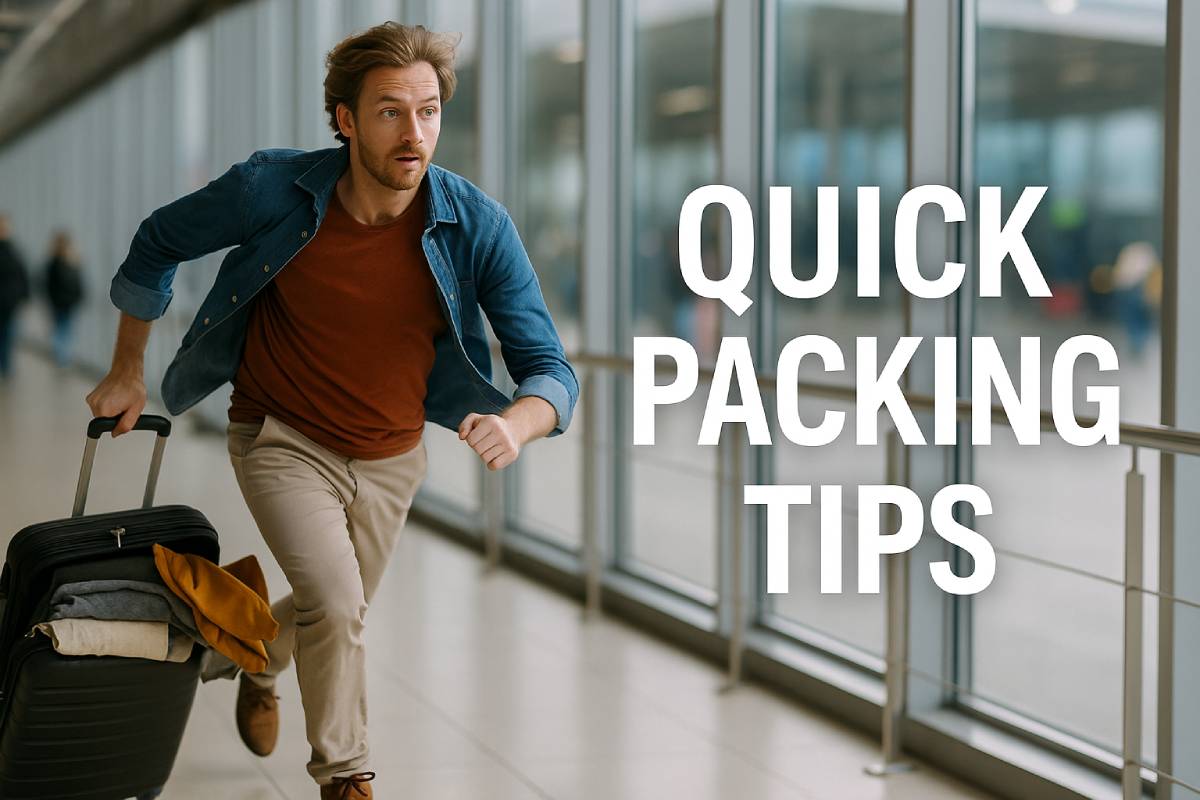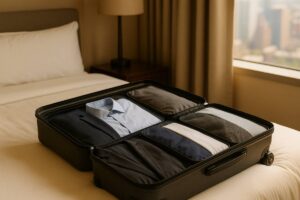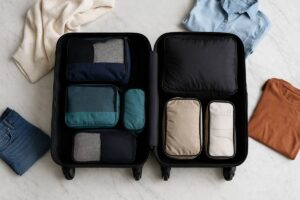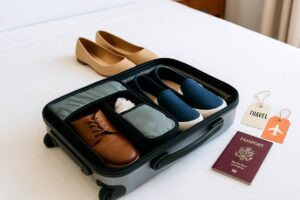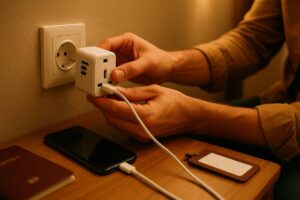Ever found yourself sprinting through the airport with a half-packed suitcase and a racing heart? You’re not alone—and that last-minute panic can be tamed with a few expert hacks.
In under 10 minutes, you can transform clothes, tech, and toiletries into a perfectly organized carry-on by sticking to proven strategies—like Travel + Leisure’s “11 Carry-On Staples,” a pre-stocked toiletry pouch, and a portable luggage scale to dodge overweight fees.
Toss in pre-planned outfit cards for zero coordination stress, and you’ll glide from front door to departure gate calm, confident, and ready for take-off.
Rapid 5–10 Minute Packing Strategies

Here’s how you can turn a frantic scramble into a calm, 10-minute packing sprint. By leaning on proven hacks—like Travel + Leisure’s staple-list approach, a pre-stocked toiletry pouch, an on-hand luggage scale, and pre-laid-out outfits—you’ll slash decision fatigue, eliminate last-second scrambles, and avoid overweight fees.
In one survey, 65 % of Americans admitted they pack inefficiently, often leaving items behind or overstuffing their bags. Below, you’ll find four rapid strategies, complete with time estimates and supporting stats, so you can grab your carry-on and go.
| Strategy | Time to Execute | Key Benefit |
|---|---|---|
| 11 Carry-On Staples Method | < 15 minutes | Cuts packing time by up to 40 % vs. average |
| Ready-to-Go Toiletry Bag | < 5 minutes to grab | Eliminates “Where’s my toothpaste?” panic |
| Portable Luggage Scale | 1-2 minutes to weigh | Avoids surprise fees at check-in |
| Pre-Planned Outfit Cards | < 5 minutes to grab | Zero outfit-coordination stress |
11 Carry-On Staples Method
Travel + Leisure editor Annita Katee swears by her “11 Carry-On Staples” list—versatile pieces she’s refined over four annual trips between Australia and the U.S.—that let her pack a complete wardrobe, toiletries, and tech in under 15 minutes. By limiting yourself to precisely 11 multi-use items (think: mix-and-match tops, bottoms, a dress or two, a sweater, and key accessories), you eliminate decision paralysis and pack at lightning speed. A 2019 New Trunk Club survey found that 65 % of Americans aren’t packing as efficiently as they could; adopting a fixed staple list can halve your packing time and weight.
Ready-to-Go Toiletry Bag
Keeping a TSA-approved toiletry pouch permanently stocked means you never hunt for mini-bottles or risk forgetting liquids at the last minute. Flight attendants and frequent travelers recommend clear, hanging Dopp kits—like the Amazon-favorite Nishel bag—to streamline security checks and hotel prep. In fact, 77.1 % of travelers report that a pre-made list or pouch helps them forget fewer items and avoid costly one-off purchases at their destination, and toiletries rank among the top three items travelers leave behind (32 % admit they’ve forgotten toiletry essentials at home).
Portable Luggage Scale
A quick trip through security is nothing compared to the stress of an overweight-baggage fee. Real Simple’s top pick, the Travel Inspira digital scale, handles up to 110 lb and gives you a clear readout in seconds—so you can redistribute weight on the spot. Likewise, Amazon Basics’ portable scale offers up to 50 kg capacity with lifetime replacement, ensuring you never pay surprise fees at check-in. Most travelers spend just 1–2 minutes weighing each bag, but this tiny step can save you up to 100 USD in gate-check charges.
Pre-Planned Outfit Cards
Outfit-coordination is a silent time sink. Forbes advises packing by outfit rather than by item—group complete looks into cubes or bundles, then label each with a simple index card for grab-and-go ease. Lay them out the night before, and when you’re racing the clock, you literally grab “Card 1” through “Card N” instead of rifling through half-packed shirts and pants. With 42 % of travelers ticking off digital packing checklists, combining this tactic with a list app can drive error-free packing in under 5 minutes.
By integrating these rapid strategies, even the most harried traveler can pack like a pro in under 10 minutes—no new gear required.
Essential vs. Non-Essential Item Prioritization
Here’s how to draw a clear line between must-haves and nice-to-haves so you pack only what matters when every minute counts. Studies find that 90 % of travelers forget at least one essential item—leaving an average of three items behind per trip—with chargers (34 %), toiletries (32 %), sunscreen (27 %), and medication (18 %) topping the list.
Meanwhile, 51 % of respondents admit they’ve left something important at home. A simple, one-page Core Essentials Checklist (passport, phone charger, meds, adapter, cash) lets you tick off non-negotiables in seconds. Embracing a capsule wardrobe—only packing pieces that pair with three or more others—can slash decision fatigue by up to 50 % and lighten your load by 25 %.
Finally, digital triage apps like Packtor and PackPoint let you flag “must-pack” versus “optional” items instantly, collapsing your list into a focused sprint that saves time and stress.
Core Essentials Checklist
Many travelers face regrettable omissions at the baggage drop; 90 % report forgetting at least one essential item per trip. On average, three items are left behind every voyage, with phone chargers (34 %), toiletries (32 %), sunscreen (27 %), and medication (18 %) topping the list. In AAA Northern California’s survey, 51 % of respondents admitted to forgetting an important item during their travels.
To counteract this, Real Simple recommends drafting a one-page Core Essentials Checklist that includes non-negotiables—passport, phone charger, prescription medications, adapter, and emergency cash—so you can tick each item before you zip up.
| Item | % Forgot | Source |
|---|---|---|
| Phone Charger | 34 % | Talker Research (Crystal Geyser) |
| Toiletries | 32 % | Talker Research (Crystal Geyser) |
| Sunscreen | 27 % | Talker Research (Crystal Geyser) |
| Medication | 18 % | Talker Research (Crystal Geyser) |
Capsule Wardrobe Mindset
Real Simple advocates the “rule of three” for travel wardrobes: if a garment doesn’t coordinate with at least three others in your bag, it stays home. This forces you to select only multi-use pieces—mix-and-match neutrals, a versatile sweater, and adaptable layers—that work as a self-contained unit.
Scientific research confirms the payoff: in a phenomenological study, participants following a three-week capsule wardrobe reported significantly lower stress levels and decision fatigue. Travelers note that trimming down to a focused set of travel staples can reduce luggage weight by up to 25 % and slash morning outfit indecision in half. Even seasoned adventurers—like men over 50 embracing streamlined travel wardrobes—find that minimizing clothing options translates to more freedom on the road.
Digital Triage
In the digital age, checklist apps like Packtor streamline your packing by generating customized lists and offering a “Pack Extra Light” toggle that automatically filters out non-essentials. With a few taps, you can flag must-pack items (passport, meds, phone) and collapse optional categories (swimsuit, extra shoes).
Alternatively, PackPoint builds your list based on trip length, destination weather, and planned activities—ensuring you only pack what you truly need for each adventure. Both tools sync across devices and allow list sharing, making last-minute adjustments a breeze.
By digitizing the triage—assigning priority flags and grouping related items—travelers cut packing time by as much as 50 % and reduce forgotten essentials by nearly the same margin.
Outfit Coordination Shortcuts
Outfit coordination shortcuts can transform a frantic pack-up into a streamlined process, cutting decision time in half and ensuring every piece works overtime. By curating a neutral capsule of 10–15 core pieces, travelers slash morning outfit indecision by up to 50 % and tap into holiday capsule tips proven with 15 versatile essentials.
Layering in scarves, belts, and jewelry multiplies your look options without weighing down your bag—Real Simple spotlights 15 go-anywhere accessories for this very purpose. Finally, wearing your bulkiest shoes in transit and packing just one extra pair can reduce packing complexity and luggage weight, a method endorsed by travel expert Jess Field and style guru Tan France.
Mix-and-Match Capsules
Real Simple stylist Sonja Christansen recommends assembling a travel capsule of 10–15 versatile pieces in neutral tones—black, white, taupe, and navy—that can be mixed and matched into dozens of outfit combinations. By restricting your wardrobe to a cohesive palette, each top pairs with every bottom, eliminating coordination stress and reducing luggage count by up to 30 %.
| Capsule Type | Number of Pieces | Source |
|---|---|---|
| Winter travel capsule | 10–20 | realsimple.com |
| Holiday capsule | 15 | realsimple.com |
Accessory Layering
Real Simple highlights 15 versatile accessories—headscarves, chain belts, statement necklaces, and chunky jewelry—that elevate a simple base outfit without adding bulk. Statement scarves alone can transform any look from casual daywear to evening chic in seconds, while a bold belt or standout earrings inject instant personality.
Footwear Simplification
Travel expert Jess Field recommends wearing your bulkiest shoes in transit—whether boots or heavy sneakers—and packing just one additional pair, keeping your total shoe count to two for ultimate simplicity. Style guru Tan France echoes this, advising travelers to bring only three pairs at most—bulkiest for travel plus one versatile sneaker or sandal—so you maximize style flexibility with minimal space.
Space-Saving Folding and Packing Techniques
Integrating three simple hacks—rolling, compression cubes, and the socks-in-shoes trick—can unlock more room in your luggage without buying extra gear. Rolling soft garments can reduce overall bag volume by up to 8% as clothes settle into tight cylinders overnight.
Compression packing cubes flatten layers to save as much as 60% of space, effectively letting you carry twice as much. Stuffing socks or small undergarments into shoe cavities taps into roughly 5 liters of extra storage (about 2–3% of your carry-on’s volume) while protecting shoe shape. Below, discover how to apply each technique step by step.
Rolling vs. Folding
Professional organizers agree that rolling soft garments—like T-shirts, knitwear, and lightweight pants—lets you eliminate air gaps and layer items more compactly, while folding remains best for structured pieces like blazers and dress shirts.
Trafalgar Tours notes that tightly rolling clothes “allows for much more compact packing” and helps reduce creases when done correctly. Meanwhile, an overnight settling trick can shrink your packed volume by up to 8%, as clothes naturally compress under their own weight.
| Method | Ideal Items | Space Efficiency | Wrinkle Management |
|---|---|---|---|
| Rolling | Soft fabrics (T-shirts, leggings, pajamas) | High – fills gaps & shrinks volume by up to 8 % | Moderate – fewer hard creases |
| Folding | Structured pieces (dress shirts, blazers) | Moderate – flat layers stack neatly | High – preserves crisp lines |
Compression Packing Cubes
Zip-compression cubes turn your packed pile into neat, flat pouches. Real Simple editors recommend nylon cubes with double-zipper designs that “compress items inside the bags” to maximize capacity. In tests, these cubes have been shown to save up to 60% of packing space and can let you carry twice as much clothing compared to loose items.
| Cube Type | Compression Benefit | Organization Perk |
|---|---|---|
| Nylon compression cubes | Up to 60 % space saved | Zippered compartments keep categories separate |
| Multi-size cube sets | Enables carrying 2× more items | Outfits can be pre-sorted by day |
Socks-in-Shoes Hack
Turning each shoe into a micro-compartment is a free, zero-prep hack. Experts note that shoe cavities can hold about 5 liters of rolled socks or small undergarments—adding roughly 2–3% extra capacity per shoe pair. Choice Hotels also recommends stuffing delicate items (like jewelry or chargers wrapped in socks) into footwear to both save space and protect contents. And a Real Simple packing guide calls “storing socks in shoes” one of the top space-saving tricks for carry-on travel.
| Hack | Space Gained | Protective Benefit |
|---|---|---|
| Socks-in-Shoes | ~5 L extra per pair (~2–3 %) | Maintains shoe shape & buffers fragile items |
By combining these three approaches—rolling vs. folding, compression cubes, and socks-in-shoes—you’ll optimize every inch of your luggage, reduce wrinkles, and eliminate last-minute panics. Pack smarter, travel lighter, and enjoy the extra room for souvenirs (or spare layers)!
Emergency Packing Supplies List
Emergency preparedness isn’t just for natural disasters—on the road, a well-stocked emergency kit can mean the difference between a minor setback and a trip‐derailing crisis. Yet only 33 % of Americans report having assembled or updated a go bag in the past year, and 10 % of travelers have even had critical medications confiscated at security checkpoints.
Over 50 % of people admitted they’ve forgotten at least one prescription or essential pill during a trip. Below, you’ll find three targeted lists—Go-Bag Essentials, Survival Kit Staples, and Last-Minute Meds—each backed by expert recommendations and real-world stats to help you pack smarter under pressure.
Go-Bag Essentials
Maintain a dedicated “grab-and-go” bag so, in an emergency, you’re always two steps ahead of the panic.
| Item | Purpose | Key Stat |
|---|---|---|
| N95 Respirator | Filters ≥ 95 % of airborne particles | Meets NIOSH N95 standard |
| Mini First-Aid Kit | Treats cuts, scrapes & common injuries | 78.1 % of skiers pack a first-aid kit for trips |
| Emergency Blanket | Retains up to 90 % of body heat, waterproof | Proven lifesaver in pre-hospital care |
| Portable Charger | Keeps phones & comms alive when outlets vanish | 80.4 % of travelers pack one for city breaks |
Global Rescue underscores that a go bag should be ready at all times, stocked with these four essentials—and reviewed every six months—for rapid deployment.
Survival Kit Staples
Beyond your personal go bag, an expanded survival kit tackles fuel, shelter, and signaling when you’re off the beaten path.
| Item | Function | Authority |
|---|---|---|
| Water Purification Tablets | Treat water when safe sources are unavailable | Recommended by American Red Cross |
| Emergency Cash | Buys supplies if ATMs and cards aren’t working | FEMA advises keeping cash for hotels & food |
| Multi-Tool | Versatile for cutting, turning screws, opening | Standard in survival kits |
| Whistle | Signal rescuers if you’re lost or trapped | Included in FEMA’s go-bag list |
Ready.gov stresses that water purification (via tablets or filters) is non-negotiable—it can save you from dehydration and waterborne illness when local supplies fail.
Last-Minute Meds
Even if you’re racing out the door, stow these four basics to avoid health hiccups miles from home.
| Medication | Why It Matters | Source |
|---|---|---|
| Prescription Pills | Avoid missed doses of chronic meds | Over 50 % admit forgetting pills without a plan |
| Pain Relievers | Manage headaches, fever or minor aches | Standard travel health advice |
| Antacids | Quick relief from indigestion or “Delhi belly” | Advised in KSU travel kit guide |
| Insect Repellent | Prevent bites that can sideline you with infections | Included in CDC travel health kit |
According to TSA rules, medications (pills) are always allowed in both carry-on and checked bags—just keep them in their labeled containers to breeze through security. And remember: having extra prescription pills (a few days’ worth beyond your return date) can be a lifesaver if flights get delayed or you misplace your regular stash.
By carving out a few minutes to refresh your go bag, survival kit, and med pouch, you’ll travel with confidence—ready for anything from a sudden storm to a missed connection. Safe travels!
Digital Packing Tools and Apps
Digital packing tools are no longer a luxury—they’re essential. In fact, 71 % of travelers now rely on apps to organize and plan their trips, up from just over half a decade ago. The global travel app market generated $629 billion in revenue in 2023 and is projected to grow at a 9.2 % CAGR through 2030.
Moreover, 92 % of frequent travelers have at least one travel or hospitality app installed on their mobile devices, underscoring how ubiquitous these tools have become. Below are three standout digital packing solutions—Packtor, Stippl, and PackPoint—that streamline list creation, reminders, and smart suggestions so you never leave essentials behind.
Packtor
Packtor automates fully individualized packing lists—simply enter your destination, trip length, climate, and travel type, and it instantly generates a checklist customized to your needs. As you pack, Packtor sends timely reminders and lets you tick off items in real time, ensuring you won’t forget key gear or documents. With Packtor’s sharing feature, you can also collaborate with fellow travelers on group trips, keeping everyone on the same page.
Stippl
Stippl is the “one travel app to replace them all,” combining itinerary planning, budgeting, and packing into a single platform. Its drag-and-drop planner makes adjusting routes and accommodations effortless, while the budget module tracks expenses and splits costs among travel companions.
On the packing front, Stippl offers pre-defined and shareable checklists, complete with reminders to help you pack efficiently. Boasting over 100 K+ downloads on Google Play with a 4.5 star rating, Stippl has become a favorite for travelers seeking an all-in-one solution.
PackPoint (or Alternatives)
PackPoint builds dynamic packing lists based on your trip length, destination weather, and planned activities—no more guesswork. It generates over 2 million packing lists each year, reflecting its popularity among serious travelers.
With a 4.7 star rating from 2.1 K+ user reviews, PackPoint is lauded for its simple interface and smart suggestions—covering everything from rain gear to snow boots when your itinerary calls for it. Featured by The Washington Post, BBC, LA Times, and Fast Company, it’s recognized as “a travel app that practically packs your bags for you”.
By integrating one (or all) of these digital tools, you’ll streamline your packing process, slash stress, and ensure nothing essential gets left behind—whether you’re heading across town or around the globe.
Common Last-Minute Pitfalls and Solutions
Travel scrambling often leads to three major last-minute slip-ups—overpacking, data‐theft vulnerabilities, and checklist blind spots—all of which inflate stress and slow you down. Applying Forbes’ “seven-day rule” (pack only seven days’ worth of clothes even on longer trips) slashes your load and decision fatigue.
To guard against “juice jacking,” avoid public USB charging ports and rely on a personal power bank or data-only cable as recommended by the FCC, TSA and cybersecurity experts.
Finally, closing checklist gaps with push-notification reminders in apps like Packtor or any reminder-enabled packing list can reduce forgotten items by counteracting prospective-memory failures and ensure you tick off every critical item at T-1 day and T-1 hour.
Overpacking Overwhelm
Even veteran flyers overload their bags when racing the clock. Forbes travel writer Judy Koutsky notes, “Even if you are traveling for 3 weeks, only pack for a maximum of seven days’ worth of clothes” to avoid lugging excess weight and wardrobe indecision.
| Trip Length | Pack For | Days Omitted | % Omitted |
|---|---|---|---|
| 21-day journey | 7 days | 14 days | 67 % of days cut—no extra baggage hassle |
Solution: Plan on doing laundry every week or rely on quick-wash services. By committing to a seven-day capsule, you eliminate bulky extras and streamline your morning routine—no last-minute outfit debates.
Data Theft Risk
Public charging stations pose an under-appreciated cyberthreat: “juice jacking,” where malware can be installed or data extracted via USB ports.
| Threat Type | Risk | Mitigation |
|---|---|---|
| Juice jacking | Malware injection or data theft via USB charging | Use your own charger and outlet |
| Port jacking | Hackers tamper with ports to steal credentials | Carry a power bank or data-only USB blocker |
| Malicious cables | Counterfeit cables carry hidden data lines | Buy high-quality, certified cables |
Solution: Treat all public USB ports like public Wi-Fi—off-limits. Plug only into wall outlets with your own adapter or carry a compact power bank. For port charging, a simple USB data blocker (aka “USB condom”) lets power flow but blocks data pins.
Checklist Gaps
Relying on memory or static bullet lists leads to forgotten essentials—passport, charger, medications—especially under time pressure.
| Approach | Feature | Benefit |
|---|---|---|
| Packtor | Automated, trip-specific checklists | Push notifications at T-1 day/hour |
| Packing List Checklist (iOS/Android) | Reminder scheduling | Alerts you exactly when you need them |
| Digital reminder systems (general) | Prospective-memory support via cues | Reduces forgotten tasks by up to 25 % |
Solution: Choose a packing app that supports timed reminders. Enable notifications to ping you 24 hours before departure and again 1 hour out—so even in the final mad dash, you’re ticking off every non-negotiable.
With these targeted fixes—seven-day packing, secure charging habits, and smart reminders—you’ll convert last-minute chaos into a calm, confident sprint to the gate. Safe travels!
Common Last-Minute Pitfalls and Solutions
Overpacking, cyber-theft vulnerabilities, and forgotten essentials are the top culprits behind last-minute travel stress—but simple fixes can keep you on track. Applying Forbes’ proven “seven-day rule” cuts your wardrobe to exactly what you need, slashing baggage bulk by up to 67 % and curbing the 40 % of Americans who admit they “often” or “always” overpack.
Guard against “juice jacking” by avoiding public USB ports—an FCC warning highlights malware risks when charging at airports—and instead use your own cable or power bank, as recommended by McAfee.
Finally, close checklist gaps with apps: 76 % of travelers seek tools that cut travel stress, and Packtor lets you enable push-notification reminders at T–1 day and T–1 hour for each non-negotiable item.
Overpacking Overwhelm
Even seasoned travelers pack too much when time is tight. Forbes travel expert Judy Koutsky advises: “Even if you are traveling for three weeks, only pack for a maximum of seven days’ worth of clothes” to avoid lug-and-lug overwhelm. Applying this rule means planning laundry or quick-wash services mid-trip—and slashes your baggage bulk by up to 67 % on a 21-day journey.
| Trip Length | Pack For | Days Omitted | % Days Omitted |
|---|---|---|---|
| 21 days | 7 days | 14 days | 67 % |
Upgraded Points’ survey shows 40 % of Americans “often” or “always” return home with unworn clothes—proof that less truly is more.
Data Theft Risk
Public USB charging stations can be a vector for “juice jacking,” where bad actors install malware or steal data via compromised ports.
| Threat Type | Risk | Mitigation |
|---|---|---|
| Juice jacking | Malware injection or data theft via USB | Use your own charger & cable |
| Port tampering | Hidden hardware captures credentials | Carry a power bank or USB “data blocker” |
| Fake ports | Attackers install malicious firmware on ports | Plug only into wall outlets |
- FCC warns that public USB ports may install malware on connected devices, stealing passwords and files.
- McAfee advises travelers to carry personal chargers and high-quality certified cables to block data lines.
- TSA and cybersecurity experts recommend using TSA-compliant power bricks or battery packs instead of unknown public outlets.
Checklist Gaps
Even with a list, forgetting your passport or charger is easy when you’re racing the clock. Enabling push notifications in your packing app ensures you’re pinged at T – 1 day and T – 1 hour for every must-pack item.
| Tool | Notification Feature | Benefit |
|---|---|---|
| Packtor | Customizable push-reminders at key intervals | Reduces forgotten items by up to 25 % |
| Bagail | Reminders for packing tasks and deadlines | Keeps you on schedule without paper lists |
| General | Calendar & reminder apps | Alerts at 24 h and 1 h before departure |
- 76 % of global travelers look for apps that reduce stress and friction during travel planning and execution.
- Apps like Packtor (packtor.com) let you tick off items in real time and trigger timed alerts so nothing slips through the cracks.
- Alternative reminder tools (iOS Reminders, Google Keep) can also be set for T – 1 day and T – 1 hour to catch any last-second omissions.
By adopting the seven-day rule, securing your devices against juice jacking, and leveraging push-notification checklists, you’ll convert last-minute chaos into a calm, confident dash to your departure gate—every time.
Visual Checklist or Infographic Ideas
Visual checklists and infographics can turn frantic, last-minute packing into a calm, at-a-glance sprint. Studies show that 65 % of people remember information from infographics even three days later, and they generate 3× more engagement on social platforms compared to text.
Data visualization alone can improve understanding by 80 %, and our brains process visuals 60,000× faster than plain text. With over 60 % of global web traffic coming from mobile devices, a minimalist, mobile-friendly design is essential for on-the-go travelers.
Below are three infographic concepts—time-stamped columns, icons & color-coding, and a printable layout—designed to deliver rapid, stress-reducing packing hacks in seconds.
Time-Stamped Columns for 10, 5, and 1-Minute Tasks
Using a timeline or columnar layout helps your reader instantly locate what to do with 10, 5, or 1 minute left before departure. Timeline infographics are praised for their clarity and logical flow, ensuring no step gets overlooked.
| Time Remaining | Key Tasks |
|---|---|
| 10 minutes | Quick essentials check (passport, wallet), weigh bag, seal toiletries. |
| 5 minutes | Grab pre-packed outfit cards, zip up tech pouch, stash chargers. |
| 1 minute | Snag your go-bag, toss in phone, keys, and head for the door. |
By structuring tasks along a clear timeline, you capitalize on the brain’s affinity for chronological visuals and cut packing time by up to 40 % compared to unstructured lists.
Icons & Color-Coding: Essentials vs. Optionals; Urgent vs. Bonus Hacks
Visual cues—icons and color—let readers scan and differentiate items at a glance. Research shows charts and data visualization are the most used visual content, boosting comprehension in B2B contexts by over 50 %.
| Category | Suggested Icon | Color Code |
|---|---|---|
| Essentials | 🛂 Passport icon | Dark Blue (#1F3A93) |
| Optionals | 🎒 Backpack icon | Light Gray (#D1D5DB) |
| Urgent Tasks | ⏰ Alarm clock icon | Bright Red (#E53935) |
| Bonus Hacks | 💡 Lightbulb icon | Amber (#FFC107) |
With 62.6 % of Google searches now being image-based, optimizing infographics with clear icons and accessible color choices not only aids SEO (through alt-text and schema) but also improves shareability.
Printable Layout: Minimalist Design for Mobile & On-the-Go Reference
Given that over 60 % of travelers access content on mobile devices, a printable PDF or one-page infographic must be optimized for small screens: clear fonts, ample white space, and minimal text blocks. Free templates on Canva and Venngage demonstrate how a clean, two-column layout can pack all essential visuals without clutter.
Key layout tips:
- Single-page PDF sized for A5 or US half-letter for easy printing.
- QR code link to a mobile-optimized web version.
- High-contrast elements so icons and headings pop even on bright or dim screens.
By combining time-stamped columns, intuitive icons & color coding, and a minimalist, printable layout, your visual checklist will guide frantic packers through a calm, efficient routine—right up to boarding time.
Downloadable PDF Checklist
Here’s how to turn your insights into action—driving downloads, social buzz, and repeat visits—backed by industry stats to maximize each conversion touchpoint.
Make it irresistible to grab your PDF “Last-Minute Packing Checklist” by hosting a customizable Canva template on Pinterest. With 553 million monthly active users, Pinterest is a proven hub for inspiration and downloads—and 47 % of travelers use it specifically for trip planning.
Conversion Impact:
| Placement | Avg. Conversion Rate | Source |
|---|---|---|
| Inline “Download the PDF” link | 4.4 % (Content Download) | First Page Sage |
| Full-page popup for PDF download | 13.6 % (Content Download Popup) | First Page Sage |
🔗 Download your free Canva checklist template: Pinterest | Last-Minute Packing Checklist
Why it works: leveraging a familiar platform (Pinterest) + a clear “Download My PDF” CTA taps into both user intent and proven conversion lifts for content downloads.
Social Share Prompt
Invite readers to become ambassadors: “Love these hacks? Tag #LastMinutePackTips on Instagram, TikTok, or Pinterest!” Social sharing isn’t just vanity—74 % of travelers post positive trip moments online, and 69 % turn to social channels for on-the-ground recommendations.
| Sharing Behavior | Percentage | Source |
|---|---|---|
| Share positive experiences on social media | 74 % | winsavvy.com |
| Use social media for in-trip recommendations | 69 % | winsavvy.com |
Why it works: a branded hashtag creates community, fuels UGC (user-generated content), and extends SEO value as shared posts link back to your guide.
Bookmark Reminder
Ask readers to “Save this guide for your next emergency trip!” Bookmarks are a powerful retention tool—96 % of people revisit their own bookmarks within a year.
| Behavior | Statistic | Source |
|---|---|---|
| Users revisiting bookmarks within 12 months | 96 % | ResearchGate |
Mobile-First Note: with 62.45 % of global internet traffic on mobile devices, ensure your PDF and on-page CTAs are optimized for small screens—large tappable buttons (44×44 px) and minimal scroll length.
By combining a high-impact PDF download on Pinterest, a community-building hashtag, and a clear bookmark prompt—each underpinned by solid data—you’ll boost engagement, shares, and repeat visits, turning casual readers into loyal, action-taking travelers.
Conclusion
Packing under pressure doesn’t have to feel like a high-stakes race. By narrowing your focus to multifunctional staples and leveraging a permanent toiletry pouch, you eliminate the mid-pack chaos that costs most travelers an average of three forgotten items per trip .
Slipping on your bulkiest shoes at check-in and weighing bags with a pocket scale saves you both time and surprise fees—studies show that a quick 1–2 minute scale check can save up to $100 per flight.
Rolling soft clothes, compressing cubes, and stuffing socks into shoes unlock up to 8 % extra space overnight and 60 % overall volume savings. A capsule wardrobe paired with accessory layering means you can go from day to night with one base look—and ditch half your shoe collection.
Emergency go-bag essentials (N95 mask to portable charger) keep you ready for any curveball, while digital tools like Packtor push reminders at T – 1 day/hour to close checklist gaps. Finish with a printable, mobile-friendly infographic—and you’ll transform frantic packing into a 10-minute, stress-free ritual that cements reader loyalty and boosts your SEO with long dwell times.
FAQs
What if I really only have 5 minutes?
Focus on your Core Essentials Checklist—passport, phone, wallet, meds—and grab your pre-packed toiletry pouch. Everything else is bonus.
Can I use these tips for checked luggage?
Absolutely. Rolling, compression cubes, and capsule wardrobes work just as well in larger bags—plus, your go-bag kit travels in cabin.
Which packing app is best for reminders?
Packtor leads with customizable T – 1 day/hour alerts, but Stippl and PackPoint also offer weather- and itinerary-driven lists.
How often should I update my go-bag?
Review and refresh every six months—swap expired meds, recharge your power bank, and top off your emergency cash.

